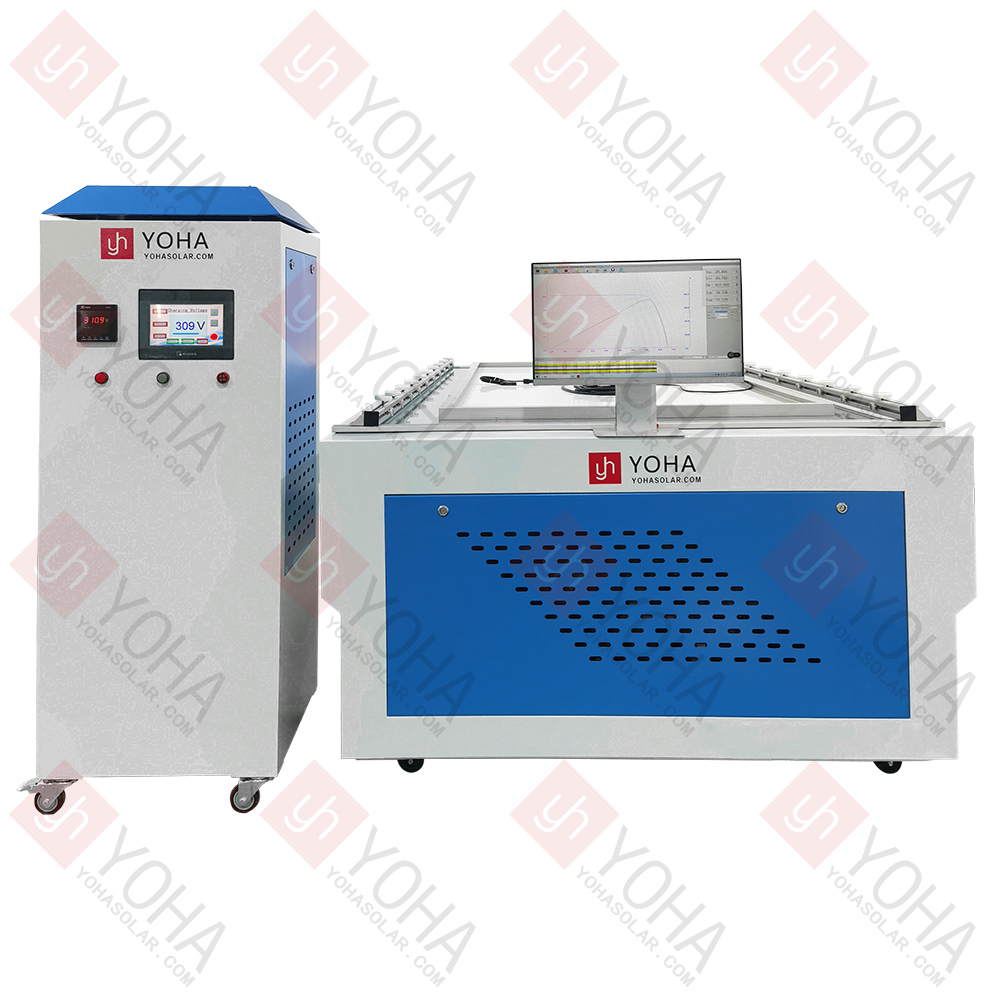Welcome to Wuhan Yoha Solar Technology Co., Ltd!
common problem
Site Map
Language:
 Chinese
Chinese
 English
English
Welcome to Wuhan Yoha Solar Technology Co., Ltd!
common problem
Site Map
Language:
 Chinese
Chinese
 English
English
In the increasingly competitive photovoltaic market, the ultimate goal of a production line lies not only in efficiency but also in excellence and consistent quality. The PV module tester, acting as the "quality gatekeeper" on the production line, plays a crucial role. A tester capable of meeting comprehensive testing demands is far from a simple power measurement tool; It is a precision diagnostic system integrating light, electricity, environment, appearance, and data management. To competent this responsibility, it must be built upon the following core functional modules.
I. Accurate and Stable Simulated Light Source System: The Foundation and Prerequisite of Testing
The source of all electrical performance testing begins with light. The primary functional module of the tester is the light source system capable of accurately simulating sunlight indoors.
Spectral Match: Natural sunlight possesses a continuous spectrum from ultraviolet to infrared. A qualified tester must have a light source spectrum that closely matches the standard solar spectrum (typically AM1.5G). Any spectral deviation will cause a distorted response for modules with different cell materials (such as mono-crystalline silicon, multi-crystalline silicon, PERC, or heterojunction), leading to systematic errors in power measurement. Therefore, the light source system must possess excellent spectral matching capability to ensure consistency between test results and real-world outdoor power generation performance.

Irradiance Uniformity and Stability: Across the entire test area (capable of covering current mainstream large-format modules), the light intensity distribution must be highly uniform and remain stable throughout the test cycle. Non-uniform illumination can cause local hot spots and current mismatch in the module, leading to an underestimation of its true power. Unstable illumination directly causes test data fluctuation and poor repeatability. High uniformity and stability are the physical foundations for ensuring accurate, reliable, and highly repeatable test results.
Transient Response and Flash Control: For testers using pulsed flash technology, the duration and waveform control of the flash are critical. It needs to provide stable, sufficient illumination in an extremely short time to simulate steady-state conditions and accurately capture the current-voltage characteristics of the module during this process, avoiding measurement errors caused by cell capacitance effects.
II. Comprehensive Electrical Performance Testing Module: The Direct Producer of Core Data
This is the core data production center of the tester, responsible for applying a scan to the module and measuring its response under light illumination.
High-Precision IV Curve Tracing: The tester must be able to rapidly and accurately trace the current-voltage (IV) curve of the module. Key parameters are directly derived from this curve: Maximum Power (Pmax), Open-Circuit Voltage (Voc), Short-Circuit Current (Isc), Voltage at Maximum Power (Vmp), Current at Maximum Power (Imp), and Fill Factor (FF). Measurement accuracy (e.g., power accuracy within ±1% or better) is the gold standard for evaluating tester performance.
Insulation Resistance & Dielectric Withstand Test (Hi-Pot): Safety is the lifeline of a module. This module tests whether the insulation performance between the current-carrying parts and the frame/ground meets the standard. It applies a high DC voltage, significantly higher than the module's operating voltage, and measures the leakage current to ensure the module does not experience leakage or breakdown in harsh environments (e.g., humidity, salt fog), safeguarding the system and personnel.
Ground Continuity Test: Another critical safety test. It verifies that the connection between the module's metal frame and the grounding path is reliable and that the resistance is sufficiently low, ensuring that current can be safely directed to the ground in case of a fault.
III. Multi-Dimensional Performance & Environmental Evaluation Modules: Insights Beyond Basic Electrical Performance
Modern production lines require more than just basic parameters; they need insights into the module's intrinsic characteristics and potential risks.
Electroluminescence Imaging Module: This is one of the hallmark features of advanced testers. When a reverse current is applied to the module, its luminescence intensity correlates directly with cell defects. EL imaging, like an "X-ray," visually detects internal defects difficult to see with the naked eye, such as micro-cracks, fragments, poor soldering, Potential Induced Degradation (PID), and impurity contamination. This function is invaluable for process improvement, failure analysis, and screening out potential early-life failure modules.
Infrared Thermal Imaging Module: While the module is operating, an infrared thermal camera captures its temperature distribution. Any abnormal hot spot indicates issues like high resistance, current mismatch, or bypass diode failure at that location. Hot spots not only reduce module output but also pose a long-term fire risk. This module is a crucial safeguard for the long-term reliability of the module.
Environmental Adaptation & Calibration: Test results need to be corrected to Standard Test Conditions (STC). Therefore, the tester needs to integrate high-precision temperature sensors to monitor the module's cell temperature in real-time and apply temperature coefficient corrections to the IV curve. Simultaneously, internal environmental monitoring (e.g., ambient temperature, humidity) is also crucial, ensuring consistency in test conditions and comparability of data.
IV. Efficient and Intelligent Mechanical Structure & Control System: The Physical Guarantee for Smooth Production
Even the most precise measurement functions require a stable and efficient mechanical platform.
Automated Loading/Unloading & Precise Positioning: To match high-speed production lines, the tester must integrate seamlessly with automated conveyor systems, including automated handling, precise positioning, and clamping mechanisms. This ensures the testing cycle time synchronizes with the production line and guarantees the optimal relative position between the module, the light source, and cameras for each test.
Integrated Multi-Test Stations & Switching: To enhance efficiency, advanced designs highly integrate IV testing, EL imaging, visual inspection, and other stations. Software control enables one-click automatic switching and measurement, minimizing module handling and positioning time.
V. Powerful Data Management & Analysis System: The Intelligent Brain for Quality Traceability and Optimization
In the Industry 4.0 era, data is the new oil. The tester is not just a measurement device but also a data acquisition terminal.
Comprehensive Data Recording & Binding: The system must automatically record all test data for each individual module, including IV parameters, EL/IR images, insulation/hi-pot results, serial number, production time, shift, etc., and achieve unique binding of the data to the physical module.
Grading Judgment & Automatic Sorting: Users can define pass/fail criteria for various parameters. Upon test completion, the system instantly performs a comprehensive judgment and outputs signals to drive the sorting mechanism, automatically diverting qualified, downgraded, and rejected modules to different areas.
In-Depth Analysis & Traceability Functions: The software platform should provide powerful data statistics, trend analysis, and report generation functions. By accumulating long-term data, it's possible to analyze power degradation trends and defect distribution patterns, providing data support for process optimization. Furthermore, with the complete data chain, full lifecycle quality traceability—tracing a module back to its original production information—becomes possible.
Conclusion
In summary, a PV module tester that meets the comprehensive testing requirements of a photovoltaic production line is a systematic engineering product, deeply integrating five core functional modules: precise light source, electrical testing, performance diagnosis, mechanical automation, and data management. Each module performs its specific duties while working in coordination, collectively ensuring comprehensive, gap-free quality control—from the most fundamental power rating of the module, to the detection of internal defects, and further to the verification of long-term safety and reliability. Investing in such a complete testing solution is not only a solemn commitment by a company to product quality but also a wise choice for building core brand competitiveness and winning long-term market trust.
keywords:TOP
18086473422
MESSAGE
